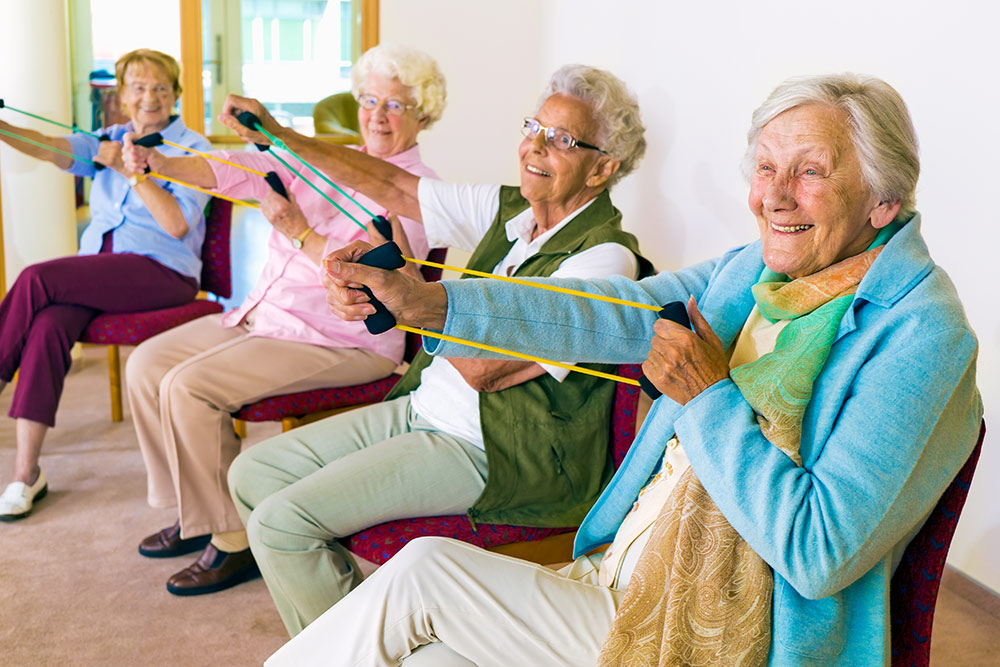Exercise is a core component of every “How to Stay Healthy” guide in books, magazines, and the internet—and for good reasons!
Exercise, together with a proper diet and healthy lifestyle, helps keep your body in the best state possible as you age. It supports your overall health and ensures that you age gracefully when you reach your prime years.
However, not all seniors view exercise as an easy endeavor. Physical activity may present some difficulties for elders with chronic conditions and limited mobility. This includes health conditions such as:
- Decrease in muscle and bone strength due to aging
- Physical disability like leg fracture
- Arthritis
- Multiple sclerosis
- Osteoporosis
- Morbid obesity
- Stroke and paralysis
- Cardiovascular diseases
Older adults with these kinds of diseases may place exercise at the bottom of their priorities. You may think that constant movement may only cause you more harm than good, but it actually doesn’t.
Studies have proven that staying physically active remains to be crucial if you want to improve your mobility.
Forgoing regular exercise only renders you weaker, less flexible, and deconditioned, making your health condition worse than it was.
To start your journey towards wellness, here are some tips to help you get started and the kinds of limited mobility exercises you can work with.
Exercise Tips for Seniors
Before engaging in any fitness routine, it is important to talk to your doctor or physical therapist first.
Ask them about what exercises you should do and those you should avoid. How many workouts you should do and what side effects to expect. Here are some helpful tips on how to safely start your workout routine.
1. Set Your Own Pace
Anyone, regardless of age, who has been in an exercise hiatus for a long time, needs to take it slow.
As a senior, you need to go at your own pace, depending on your current fitness level. You can start with a routine that brings you enjoyment, like walking your dog or playing with grandkids. Even a simple stretching workout would suffice for the first few days.
Begin by working out three times a week. You can do a 30-minute session or spread it out in 10-minute sessions throughout a single day.
Give your body time to adjust. Start slow, rest in between minutes, and keep your expectations within reach.
2. Make It a Routine
Make it a point to exercise and get moving regularly. Gradually include it in your day to day routine and make a habit out of it.
Studies suggest that it takes a month of regularly doing an activity to establish it as a habit successfully. Begin with a routine—a specific time of the day (preferably morning) and place to do your daily exercise. You can change your actual workout every now and then to prevent boredom.
Establishing a workout ritual helps you and your body to get used to the idea of exercising. Regular physical activity also provides several benefits, such as:
- Increase energy levels
- Enhance mood
- Establish better sleep
- Weight management
- Disease prevention
- Good physique

3. Warm-Up and Cool Down
If you have been inactive for months or years, it is important not to overexert yourself by jumping into a routine immediately—without warming up or cooling down.
Warm-ups and cool-downs improve your exercise performance. Both are critical to any routine to prep your body for the incoming exertion and to avoid injuries.
Before you start, make sure to do a proper warm-up first. This helps your heart gradually increase its rate, preparing it for the incoming stress. It also dilates your vessels to provide muscles with enough oxygen, optimizing muscular flexibility, and efficiency.
After a session of physical activity, make time for a 5-minute cool down until your heart rate gets to its average level.
Cooling down makes your body—limbs, joints, and muscles—slowly go back to their resting state. Without it, then you risk cramping up your muscles or passing out or feeling sick all of a sudden.
4. Ups and Downs Are Normal
It is okay to feel unmotivated on some days or skip some workout sessions. There are also some moments where you will feel like nothing is happening. This is all normal.
Limited mobility exercises take time to have a physical manifestation in your health and body. But that does not mean that it doesn’t work. In fact, a week of regular exercise already has a positive effect on your body.
The key is to set realistic goals and to be patient with yourself. Everything takes time.
5. Listen to Your Body
The most important thing to do is to listen to your body. Make the most out of your journey by staying safe when exercising.
You can do every routine with someone—a loved one or a therapist—for guidance and physical support. If you experience any pain or uneasiness, stop exercising immediately. May it be simple nausea or clammy hands, report it to your general practitioner as soon as possible.
Avoid exercising the injured or healing part of your body. It is better to have someone professional do a separate physical therapy for it.
Prioritize your safety at all times.
Limited Mobility Exercises to Try
For endurance exercises, you can try those that get your heart and blood pumping. This includes:
- Swimming
- Water aerobics
- Tennis or Badminton
- Walking
- Light jogging
Exercises that focus on strengthening the muscles should also be necessary. It helps the body build muscle and bone mass, improve resistance, and enhance balance.
You can try lightweight routines like chair exercises, squats, or lifting about one to two pounds of weight.
Lastly, do not forget to include some flexibility exercises into your routine. You can do workouts such as:
- Stretching (quadriceps, back, inner thigh, calves, and hip)
- Yoga
- Tai chi
- Seated lifts
This will enhance your range of motion and muscle flexibility. It will also reduce any body pains you have and prevent your muscle from atrophying. A stretching routine can also help out in easing your stress and anxiety.

